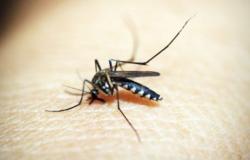The respiratory syncytial virus (RSV) proliferates in poorly ventilated and crowded environments and causes a highly contagious disease. O respiratory syncytial virus (RSV), which belongs to the genus Pneumovirus, is one of the main agents of an acute infection in the respiratory tract, which can affect the bronchi and lungs.
In most cases, it is responsible for the appearance of bronchiolitis acute (inflammation of the bronchioles, increasingly thinner branches of the bronchi that penetrate the pulmonary alveoli) and pneumonia, especially in premature babies, in the first year of life. Even those who received antibodies from their mothers during pregnancy are vulnerable to respiratory syncytial virus infection.
According to the American Association of Pediatrics, in addition to premature babies, those at risk for developing severe forms of the disease include those with congenital heart disorders, chronic lung diseases and congenital or acquired immunodeficiency. Passive smoking, poorly ventilated environments with lots of people, early weaning as it can affect the strengthening of the child’s immune system, are other conditions that favor the manifestation of these infectious conditions.
What does RSV infection look like?
RSV infection is highly contagious. There is evidence that by the age of three, all children have already come into contact with this virus without developing a severe form of the disease. Furthermore, as it does not provide permanent immunity, throughout life the person may experience recurrent episodes of the disease, but with less aggressive symptoms.
Despite not being associated with low temperatures, cases of RSV infection are more frequent in late autumn, winter and early spring, which, in the southern hemisphere, corresponds to the months between May and September. In locations with a tropical or subtropical climate, seasonal outbreaks occur more during the rainy season.
Anyone can be infected with respiratory syncytial virus. Clinical manifestations vary according to age (at both ends of life they are more severe), previous exposure to the virus and the existence of underlying diseases.
The respiratory syncytial virus penetrates the healthy organism through the mucous membranes of the mouth, nose or eyes, and can remain there for weeks. The transmission period begins two days before symptoms appear and only ends when the infection is completely controlled.
How does RSV spread?
Contagion occurs through direct contact with the secretions eliminated by the infected person when coughsneezing or talking and, indirectly, through contact with contaminated surfaces and objects, in which the virus can survive for several hours.
Respiratory syncytial virus infection can be asymptomatic. However, the majority of infected people develop a self-limited illness, that is, the symptoms disappear spontaneously within a few days. The incubation period lasts, on average, five days. In adults and older children in good health, the symptoms are similar to those of the common cold – nasal discharge, sneezing, dry cough, low-grade fever, sore throat and headache.
As the disease progresses, however, the infection can reach the lower respiratory tract and affect bronchioles, alveoli and lungs. Therefore, the following clinical signs deserve attention and care: high fever, a lot of coughing, difficulty breathing, nasal tingling (accelerated beating of the wings of the nose caused by obstruction of the airways), cyanosis of the lips and extremities (purplish lips and nails) , wheezing (wheezing or wheezing in the chest caused by the narrowing of inflamed bronchi), intercostal insufficiency (retraction and sinking of the spaces between the ribs during inspiration), lack of appetite, lethargy.
How is RSV diagnosed?
Diagnosis takes symptoms into account, especially at times of year when respiratory syncytial virus infection is more common.
Laboratory tests carried out on blood or secretion samples collected from the patient’s nose and throat can be useful to identify the presence of the virus or its antibodies and alert health agencies about the occurrence of seasonal epidemic outbreaks. A chest x-ray is another test available to confirm the diagnosis.
Prevention is directly associated with basic hygiene care, especially nasal wash frequent cleaning of hands with soap and water, the application of alcohol gel before and after coming into contact with the patient and the disinfection of surfaces and objects exposed to body secretions contaminated by the virus. Avoiding crowds in closed spaces and keeping distance from people who show signs of the disease are other important measures to control the spread of RSV.
Is there medicine for RSV?
In a significant advance for public health, the National Health Surveillance Agency (Anvisa) granted, in April 2024, approval for the registration of Abrysvo vaccinedeveloped by the pharmaceutical company Pfizer.
Children up to two years of age, at high risk of developing serious complications if infected by the respiratory syncytial virus, can count on a prophylactic medication – humanized monoclonal immunoglobin – to prevent the severe form of the disease. It is called palivizumab, registration was approved by Anvisa and free distribution is guaranteed by SUS. The medicine must be administered in five consecutive doses, one every 30 days. The first must be applied one month before the start of the seasonal period expected for greater circulation of the virus.
As is the case with most viruses, treatment is symptomatic. In most cases, it is enough to resort to medication to reduce fever, relieve pain and discomfort, rest, drink plenty of fluids to avoid dehydration and stay in environments with humidified air to facilitate the exit of nasal secretions and calm the condition. cough.
Patients with severe respiratory failure must be hospitalized to receive mechanical ventilation support and specific medications, such as bronchodilators and antibiotics, if there is an associated bacterial infection, which can worsen the condition and even lead to death.
The antiviral drug ribaverin, used in the form of a microparticulate aerosol, demonstrated beneficial effects in the treatment of lower respiratory tract infection caused by RSV. However, although this drug has received approval from the American FDA (Food and Drug Administration), it is contraindicated for children who require assisted ventilation and for women who are pregnant or intend to become pregnant, because it may harm the development of the fetus.
Tags: Find Respiratory Syncytial Virus
--





